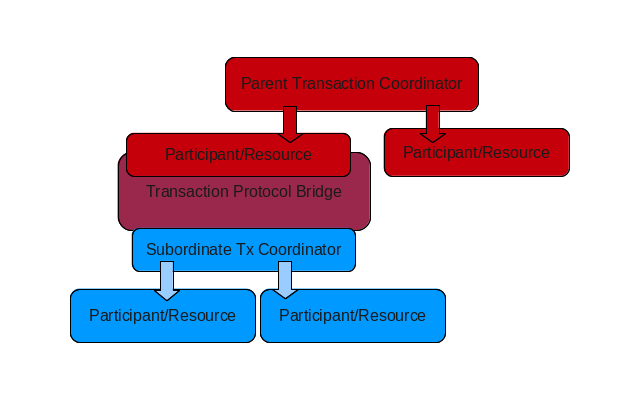Transactions provide a structuring mechanism for business logic. Use of transactions allows for grouping of data manipulations into constructs with certain properties. Traditional ACID transactions provide for properties of Atomicity, Consistency, Isolation and Durability.
In JavaEE applications, transaction support is provided via the Java Transaction API (JTA). The classes and interfaces in the javax.transaction and javax.transaction.xa packages provide a means by which the programmer may manage transaction demarcation (begin, commit, rollback) and, where necessary, interact with the transaction management system (e.g. enlistResource). In many JavaEE applications, further abstractions are provided on top of the JTA. For example, EJB3 @TransactionAttribute annotations may be used for transaction boundary demarcation in preference to explicit calls to the JTA's UserTransaction interface.
In distributed applications, the JTA implementation may provide propagation of transaction context and transaction control calls between containers (JVMs) using either a propriety transport or JTS, the Java mapping of the CORBA OTS standard on an RMI/IIOP transport. In JBossTS, both local and distributed (JTS) implementations of the JTA are available.
In Web Services applications, ACID transaction management and interoperable context propagation is provided for by the WS-AT standard. JBossTS XTS provides an implementation of both the 1.0 and 1.2 versions of this standard. Bridging is provided only on the more recent version. At the time of writing the standard covers only the web services API and protocol, not the Java API through which the protocol may be driven. Therefore, XTS provides a custom Java API to users, with characteristics broadly similar to the JTA.
For applications that combine traditional JavaEE transaction management and Web Service transaction management, it is often desirable to have some mechanism for linking these transaction types, such that a single transaction may span business logic written for either transaction type. Examples include exposing existing JavaEE transactional business logic (e.g. EJBs) as transactional Web Services, or allowing JavaEE transactional components to utilize transactional Web Services.
We use the term Transaction Bridging to describe the process of linking the JavaEE and Web Services transaction domains. The transaction bridge component (txbridge) of JBossTS provides bi-directional linkage, such that either type of transaction may encompass business logic designed for use with the other type.
The technique used by the bridge is a combination of interposition and protocol mapping.
Interposition is used in transaction systems to allow a tree of transaction coordinators to be constructed, usually for performance reasons. Interposed coordinators function as transaction managers for nodes below them in the tree, whilst appearing as resources (participants in WS-AT terminology) to the node above them.
Within a single transaction domain, interposition may be used to allow remote nodes to minimize the number of network calls necessary at transaction termination. The top level node is known as the root coordinator, whilst interposed coordinators are termed subordinate. This name indicates that they are not autonomously responsible for determining the transaction outcome, but rather are driven by their parent coordinator. Therefore, whilst a top level coordinator exposes only the commit and rollback methods for transaction termination and handles the 2PC internally, the subordinates additionally expose the prepare method to their parent, behaving much like resources during the termination protocol.
In the transaction bridge, an interposed coordinator is registered into the existing transaction and performs the additional task of protocol mapping. That is, it appears to its parent coordinator to be a resource of its native transaction type, whilst appearing to its children to be a coordinator of their native transaction type, even though these transaction types differ.
The interposed coordinator is responsible for performing mapping between the transaction protocols. There is a strong correspondence between the API and protocol used by the JTA and WS-AT transaction types, which is unsurprising given their common heritage and shared problem domain. However, method signatures, exception types and such do differ. The bridge provides a abstraction layer to mask these distinctions as far as possible.
The net result of this is that existing business logic perceives its expected transaction environment, even though the transaction in which it is executing may be subordinate to one of a different type. No changes are necessary to existing transactional applications to allow them to operate in the scope of foreign transactions. This facilitates reuse of existing business logic components in new environments and increases the possibilities for new architectures and interoperability.

